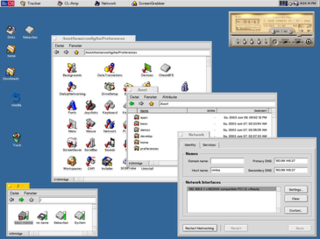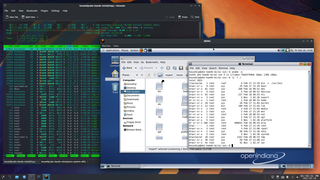
A users' group (also user's group or user group) is a type of club focused on the use of a particular technology, usually (but not always) computer-related.

A users' group (also user's group or user group) is a type of club focused on the use of a particular technology, usually (but not always) computer-related.
Users' groups started in the early days of mainframe computers, as a way to share sometimes hard-won knowledge and useful software, usually written by end users independently of the vendor-supplied programming efforts. SHARE, a user group originated by aerospace industry corporate users of IBM mainframe computers, was founded in 1955 and is the oldest computer user group still active. DECUS, the DEC User's Society, was founded in 1961 and its descendant organization, Connect Worldwide, still operates. The Computer Measurement Group (CMG) was founded in 1974 by systems professionals with a common interest in (mainframe) capacity management, and continues today with a much broader mission. The first UNIX users' group organized in 1978.
Users' groups began to proliferate with the microcomputer revolution of the late 1970s and early 1980s as hobbyists united to help each other with programming and configuration and use of hardware and software. Especially prior to the emergence of the World Wide Web, obtaining technical assistance with computers was often onerous, while computer clubs would gladly provide free technical support. Users' groups today continue to provide "real life" opportunities for learning from the shared experience of the members and may provide other functions such as a newsletter, group purchasing opportunities, tours of facilities, or speakers at group meetings.
A users' group may provide its members (and sometimes the general public as well) with one or more of the following services:
Users' groups may be organized around a particular brand of hardware (e.g., Mac), software and operating systems (e.g. Linux), or more rarely may be dedicated to retro systems (e.g., Apple II). An example of an early user group is the Apple User Group Connection.
A computer user group (also known as a computer club) is a group of people who enjoy using microcomputers or personal computers and who meet regularly to discuss the use of computers, share knowledge and experience, hear from representatives of hardware manufacturers and software publishers, and hold other related activities. They may host special interest workgroups, often focusing on one particular aspect of computing.
Computer user groups meet both virtually and in hackerspaces. Computer user groups may consist of members who primarily use a specific operating system, such as Linux. While many hackers use free and open source software, others use Macintosh, RISC OS, Windows and Amiga OS. There are also other user groups that concentrate on either Mac OS (Macintosh User Group or MUG) or Linux (Linux User Group or LUG).
Many computer user groups belong to an umbrella organization, the Association of Personal Computer User Groups or APCUG.

BeOS is a discontinued operating system for personal computers that was developed by Be Inc. It was conceived for the company's BeBox personal computer which was released in 1995. BeOS was designed for multitasking, multithreading, and a graphical user interface. The OS was later sold to OEMs, retail, and directly to users; its last version was released as freeware.
IBM mainframes are large computer systems produced by IBM since 1952. During the 1960s and 1970s, IBM dominated the computer market with the 7000 series and the later System/360, followed by the System/370. Current mainframe computers in IBM's line of business computers are developments of the basic design of the System/360.

A Linux distribution is an operating system made from a software collection that includes the Linux kernel and often a package management system. They are often obtained from the website of each distribution, which are available for a wide variety of systems ranging from embedded devices and personal computers to servers and powerful supercomputers.

A mainframe computer, informally called a mainframe or big iron, is a computer used primarily by large organizations for critical applications like bulk data processing for tasks such as censuses, industry and consumer statistics, enterprise resource planning, and large-scale transaction processing. A mainframe computer is large but not as large as a supercomputer and has more processing power than some other classes of computers, such as minicomputers, servers, workstations, and personal computers. Most large-scale computer-system architectures were established in the 1960s, but they continue to evolve. Mainframe computers are often used as servers.

An operating system (OS) is system software that manages computer hardware and software resources, and provides common services for computer programs.

Computer operating systems (OSes) provide a set of functions needed and used by most application programs on a computer, and the links needed to control and synchronize computer hardware. On the first computers, with no operating system, every program needed the full hardware specification to run correctly and perform standard tasks, and its own drivers for peripheral devices like printers and punched paper card readers. The growing complexity of hardware and application programs eventually made operating systems a necessity for everyday use.
A computing platform, digital platform, or software platform is the infrastructure on which software is executed. While the individual components of a computing platform may be obfuscated under layers of abstraction, the summation of the required components comprise the computing platform.
System software is software designed to provide a platform for other software. Examples of system software include operating systems (OS).
MkLinux is an open-source software computer operating system begun by the Open Software Foundation Research Institute and Apple Computer in February 1996, to port Linux to the PowerPC platform, and Macintosh computers. The name refers to the Linux kernel being adapted to run as a server hosted on the Mach microkernel, version 3.0.
PlainTalk is the collective name for several speech synthesis (MacinTalk) and speech recognition technologies developed by Apple Inc. In 1990, Apple invested a lot of work and money in speech recognition technology, hiring many researchers in the field. The result was "PlainTalk", released with the AV models in the Macintosh Quadra series from 1993. It was made a standard system component in System 7.1.2, and has since been shipped on all PowerPC and some 68k Macintoshes.
These tables provide a comparison of operating systems, of computer devices, as listing general and technical information for a number of widely used and currently available PC or handheld operating systems. The article "Usage share of operating systems" provides a broader, and more general, comparison of operating systems that includes servers, mainframes and supercomputers.
A Macintosh User Group (MUG) is a users' group of people who use Macintosh computers made by Apple Inc. or other manufacturers and who use the Macintosh operating system (OS). These groups are primarily locally situated and meet regularly to discuss Macintosh computers, the Mac OS, software and peripherals that work with these computers. Some groups focus on the older versions of Mac OS, up to Mac OS 9, but the majority now focus on the current version of Mac operating system, macOS.
The usage share of an operating system is the percentage of computers running that operating system (OS). These statistics are estimates as wide scale OS usage data is difficult to obtain and measure. Reliable primary sources are limited and data collection methodology is not formally agreed. Currently devices connected to the internet allow for web data collection to approximately measure OS usage.

In computing, virtualization (v12n) is a series of technologies that allows dividing of physical computing resources into a series of virtual machines, operating systems, processes or containers.

A Unix-like operating system is one that behaves in a manner similar to a Unix system, although not necessarily conforming to or being certified to any version of the Single UNIX Specification. A Unix-like application is one that behaves like the corresponding Unix command or shell. Although there are general philosophies for Unix design, there is no technical standard defining the term, and opinions can differ about the degree to which a particular operating system or application is Unix-like.
Mac operating systems were developed by Apple Inc. in a succession of two major series.

Computers can be classified, or typed, in many ways. Some common classifications of computers are given below.

Mac OS is the series of operating systems developed for the Macintosh family of personal computers by Apple Computer, Inc. from 1984 to 2001, starting with System 1 and ending with Mac OS 9. The Macintosh operating system is credited with having popularized the graphical user interface concept. It was included with every Macintosh that was sold during the era in which it was developed, and many updates to the system software were done in conjunction with the introduction of new Macintosh systems.
Comparison of user features of operating systems refers to a comparison of the general user features of major operating systems in a narrative format. It does not encompass a full exhaustive comparison or description of all technical details of all operating systems. It is a comparison of basic roles and the most prominent features. It also includes the most important features of the operating system's origins, historical development, and role.